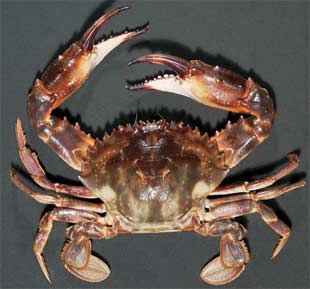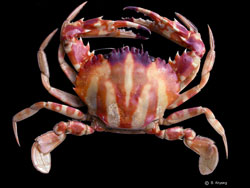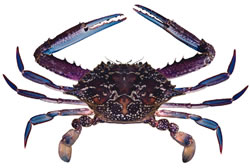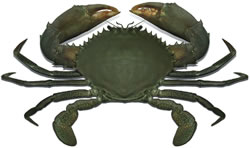Asian paddle crab
Introduction
The Asian paddle crab, sometimes called lady crab, can vary in colour from red/purple/orange to pale green and off-white. It has six distinct spines either side of the eyes with the shell width reaching 12cm.
It is an aggressive crab that can outcompete with native species for food and habitat. It is also known to carry the White Spot Syndrome Virus that can impact native and farmed prawns, crabs and lobsters.
The Asian paddle crab is listed as prohibited matter under the NSW Biosecurity Act 2015 and is considered a major threat to native fauna and the environment. It may not be brought into NSW or released or allowed to escape into any waters in NSW.
Reporting
If you think you have seen a Asian paddle crab in NSW, please take several high resolution photos or collect a sample and freeze in a plastic bag and report your sighting. For identification photos should show:
- Claws and spines either side of eyes
- Crab size - please include something for reference
- Shell colour and markings
Identification
Asian paddle crab / Charybdis japonica

Key features:
- Varied colour from red/purple/orange to pale green and off white
- 6 spines either side of eyes
- Shell width up to 12cm
- Swimming paddles on last set of legs
Known locations:
- Single live male found in SA
- Not known to occur in NSW
Habitat:
- Estuarine and marine habitats
- Subtidal to 10-15m depth
Impacts:
- Is host/carrier of the White Spot Syndrome Virus which can infect native and farmed prawns, crabs and lobsters
Similar native species
These native species may be confused with this marine pest.
Crucifix or coral crab (Charybdis feriata)

Key features:
- 6 broad teeth on either side of eyes
- 8 rounded teeth between the eyes (Note: in C. japonica the teeth are sharp)
- Pattern of orange/brown and white longitudinal strips on carapace
- Legs and claws orange/brown with scattered white spots
- Shell width up to 20 cm
- Swimming paddles on last set of legs
Habitat:
- Sandy and muddy sustrates from shore to 30 m depth
Blue swimmer crab (Portunus pelagicus)

Key features:
- No spines either side of eyes
- Dark brown/bluish/purple colour
- Shell width up to 21cm
Habitat:
- Sheltered sand and seagrass habitat
- Intertidal and subtidal up to 60-70m depth
Mud crab (Scylla serrata)

Key features:
- 9 spines either side of head
- Dark brown to mottled green
- Large robust claws Shell up to 25cm wide
Habitat:
- Soft muddy bottoms in sheltered areas such as mangroves